Carter Ham On AUSA 2019 & What’s At Stake For The Army
Posted on
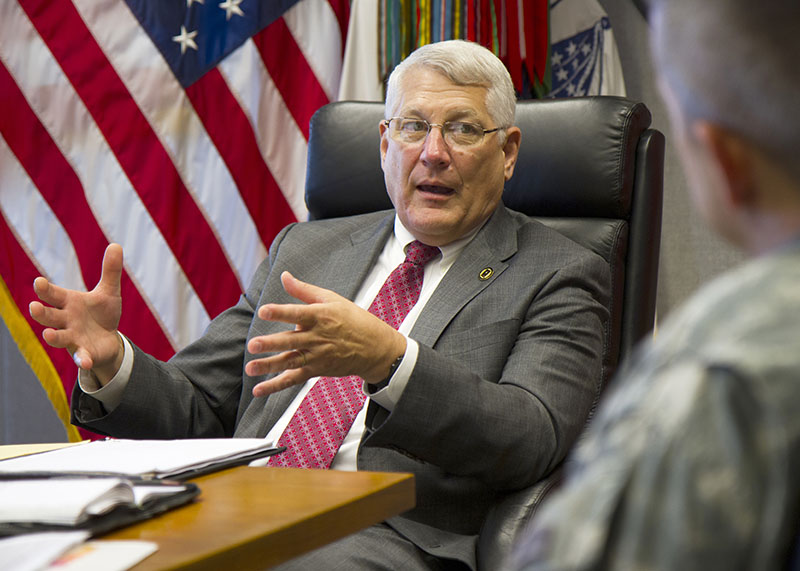
Gen. (ret.) Carter Ham
WASHINGTON: As more than 30,000 people — soldiers, civil servants, contractors and reporters — converge on downtown DC Monday for the largest Army conference of the year, the 2020 budget remains gridlocked on Capitol Hill. The fiscal impasse threatens the Army’s ambitious modernization drive just as its costs and challenges increase with each program moving from concept to prototype to production.
“Certainly, the last few years have been quite good, I think, for the association’s annual meeting and for the Army,” the president of the Association of the US Army, retired Gen. Carter Ham, told me earlier this week. “We last year had just over 31,000 attendees. We think we’ll be close to that, maybe exceed it this year.”
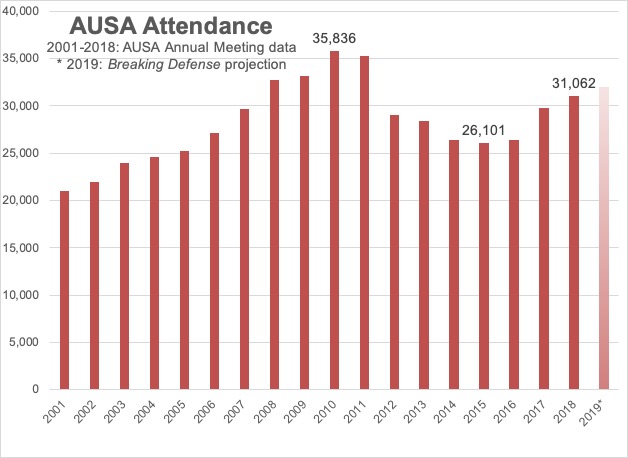
Breaking Defense graphic from AUSA data
Attendance at AUSA’s Army’s annual meeting each October is a pretty good proxy for the defense industry’s confidence in the future of its Army customers, and it has been growing steadily since its nadir in 2015, when the military was reeling from Budget Control Act cuts. But amidst high-profile battles over President Trump’s impeachment and his contentious border wall, the 2020 budget may never pass at all. That would leave Pentagon spending on autopilot all year at 2019 levels – under a legislative stopgap called a Continuing Resolution – with no legal authority to start new programs or grow existing ones.
It’s especially important for the Army, which is now starting and growing more programs than it has in years. That’s hard enough even with stable and predictable funding.
Sure, some of the smaller items seem to be moving swiftly into the field, like new night vision goggles with built-in targeting cross-hairs and other virtual reality overlays. But big programs for big hardware are much harder. All told, the Army’s three-star chief of long-term budget planning counts 10 major programs that must move into production between now and 2026, a modernization challenge on a scale the service hasn’t seen since the Reagan buildup more than 30 years ago. Just this month, experts and industry were shocked when the Army disqualified one of only two competitors for its Optionally Manned Fighting Vehicle, a highly automated replacement for the M2 Bradley troop carrier.
“It is a little bit troubling,” said Ham, who can’t remember a major vendor being disqualified like this before. “I suspect we will learn more [about the decision], perhaps as early as next week,” he said, “[but] it is always healthier to have a competition, and hopefully that’s where we’ll end up.”
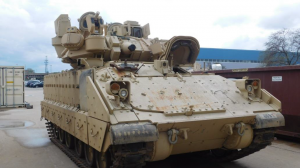
The latest upgrade to the aging M2 Bradley, with the Iron Fist-Light Active Protection System installed (Rada photo)
OMFV is supposed to award key development contracts early next year. So is the Army’s highest-priority aerial scout program, the Future Attack Reconnaissance Aircraft. None of that can happen under a Continuing Resolution unless a gridlocked Congress can negotiate case-by-case anomalies for each program. The Pentagon is already operating under a short-term CR, since fiscal year 2020 began Oct. 1st, but the real danger of program delays comes if that CR is extended into spring or, worse yet, for the rest of the fiscal year.
But there are things even worse than a 12-month CR, Ham told me. “The worst possible outcome would be a government shutdown,” he said. “This [current] continuing resolution expires on the 21st of November. If the Congress and the president are not able to agree on funding going forward at all and there’s a shutdown, that obviously is the very worst case and would be disastrous, not just for defense but across the government.”
“An extension to the continuing resolution, any extension, is better than a shutdown, but any extension is worse than appropriation and authorization,” Ham said, referring to the two congressional processes required for regular order.
Read on for extended edited excerpts of our conversation with Gen. Ham on these and other subjects.
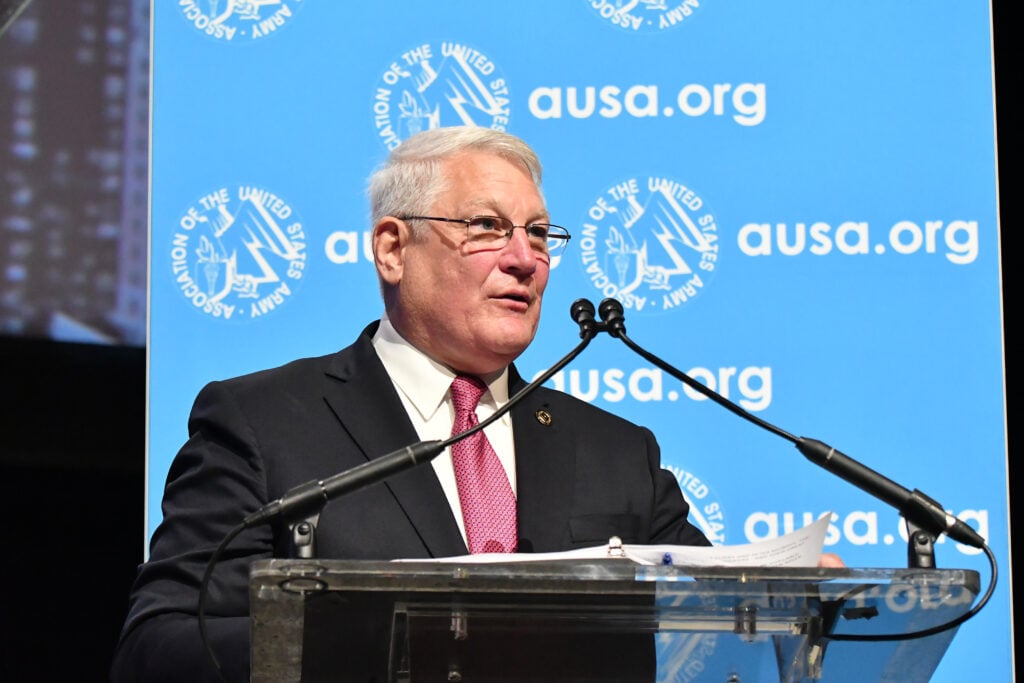
Gen. (ret.) Carter Ham
Q&A with Carter Ham
Sydney Freedberg, Breaking Defense: What’s your sense of how the show has been doing over the last few years?
Gen. (Ret.) Carter Ham, Association of the US Army: The strength of the meeting is a reflection of a couple of things. One, while there is still certainly some budget uncertainty in the current fiscal year, the Congress removed the threat of sequestration and the budget caps, and they decided upon a top line for a defense for the next two years. It’s very reassuring to the Army, very reassuring to the businesses that support the Army — obviously with appropriations to be still determined.
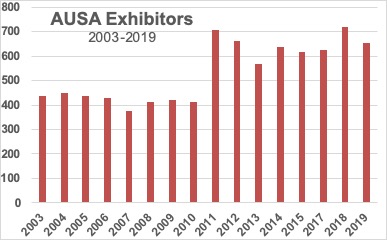
While there are fewer exhibitors this year, the average size of their displays is larger, AUSA says.
Breaking Defense graphic from AUSA data
Secondly, this year in particular, with a new secretary, a new chief, a new sergeant-major of the Army, and several new four-stars, the Army congressional leaders, media, and industry are keenly interested in hearing what direction the new cohort of senior leaders will take the Army.
So all of those things combined, I think, built a very strong and very healthy outlook for this year’s annual meeting.
The mid 2000s, with such heavy operational deployments, were a time that understandably drove very high attendance and participation at the association’s annual meeting. But I don’t think that was normal. I am very comfortable and very confident that in this 30,000-ish attendance is a good, strong number. I think it conveys an interest on the part of industry. I think it conveys, certainly, a high level of interest from the Army senior leadership and from our own association membership.
92 different nations will be represented at the annual meeting next week; that’s a bigger number than we have seen in the past. And 13 chiefs of armies are so far registered to attend; that’s a bigger number than we have seen in the past as well. Some of that is certainly attributable to Gen. [James] McConville now being chief of staff of the Army, and his counterparts around the world see this as an opportunity to meet him.

Breaking Defense graphic from 2019 budget “Green Book” data
Sydney: You mentioned the budget uncertainty. We now have an impeachment inquiry on top of the usual partisan potential for gridlock. Obviously, we are on a short-term Continuing Resolution now, but how concerned are you about rolling perpetual CRs well into next year?
Gen. Ham: Sydney, I’m very, very worried about that. We are now two weeks into the fiscal year. There is no defense authorization act. There is no defense appropriation. There is a short-term Continuing Resolution through 21 November — and the mere fact that people are even talking about a six-month or even full-year Continuing Resolution is just crazy. A year-long containing resolution would essentially stalemate the significant progress the Army is making in modernization, because as you know very well, it’s no new starts, no new money for new projects. And the Army needs to do that this year.
I’m deeply concerned that the political issues will consume all of the energy of the Congress and of the White House. What I worry about a long-term Continuing Resolution, and particularly a year-long Continuing Resolution, is that then the next authorization and appropriation are for fiscal year 21, which is the presidential election year. If we think things are tense now politically, one can only imagine how much more difficult they may become in a highly contested presidential election season.
The Congress has an obligation, they have a duty, to get this work done and deliver it to the president.
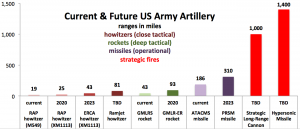
RAP: Rocket Assisted Projectile (current M549A1 or future XM1113). ERCA: Extended Range Cannon Artillery. GMLRS-ER: Guided Multiple-Launch Rocket System – Extended-Range. ATACMS: Army Tactical Missile System. PRSM: Precision Strike Missile.
SOURCE: US Army. SLRC and Hypersonic Missile ranges as reported in Army Times.
Sydney: And we are moving into a critical phase for Army modernization. This is the hard part, when you actually start procuring things, where things are having to turn from PowerPoint to reality.
Gen. Ham: That’s exactly right. And that’s why adequate, assured funding is so necessary, particularly for the new starts. The Army in these next few years is at a very critical juncture.
There are still improvements necessary in near-term readiness, though significant progress has been made over the past few years. But over the next few years, again depending on appropriations and authorization, we will start to see a shift, from investing in near-term readiness, more and more into future readiness — building that the capabilities that the Army needs for a return to great power competition in a much more lethal, fast paced, multi-domain environment.
I think all the modernization priorities – particularly Long-Range Precision Fires — are a demonstration that the Army leadership understands that the environment in which the Army will be required to operate in the future is different than today, different than any we’ve experienced, that requires vastly different capabilities.
One of the challenges is, what are the capabilities required for weapon systems that have that very long range to strike a target with precision? In cannon artillery, you have a forward observer, either on the ground or in an aircraft: He has eyes on the target and is able to direct fires onto the target. That’s not what we’re talking about here because of the extended ranges. So what is that process?

The cancelled Crusader howiter
Sydney: Even if the Army gets the money, it’s still entirely possible for such complex programs to fail, to go over budget, or be canceled outright. We’ve had a long unhappy history in the Army, basically since 1991, of many major programs being canceled without delivering a product. How tough is this specter of the past to shake off?
Gen. Ham: The specter of failed modernization programs is present in the Congress. It is present with defense industry. And clearly, the Army senior leadership is fully aware of that history.
One of the ways to combat it has been the Army’s very concerted effort to establish the highest modernization priorities and stick to them. We have heard that the secretary, both past and present, the chief both past and present, the assistant secretary for acquisition, and the commander of Army Futures Command consistently say the Army is not changing its priorities.
That’s an important message to come from leaders. What’s even more important than their verbal assurances has been to see that prioritization is manifest in the Army budget that had been submitted and hopefully will be approved by the Congress and ultimately by the president. This cohort of senior leadership means what they say, they’re committed to these modernization priorities, they’re putting their reputations and real money against the modernization initiatives.
There is a fair degree of skepticism that says, ‘Okay, we hear you, we see the budget, let’s see the product. Let’s see something in the hands of soldiers fast.’ Everybody’s watching. Can the Army deliver what they say they want and need to deliver? This will not surprise you to learn that I am optimistic that because I know and believe in the leadership of the Army. But Congress has got to do its part also.
Subscribe to our newsletter
Promotions, new products and sales. Directly to your inbox.
